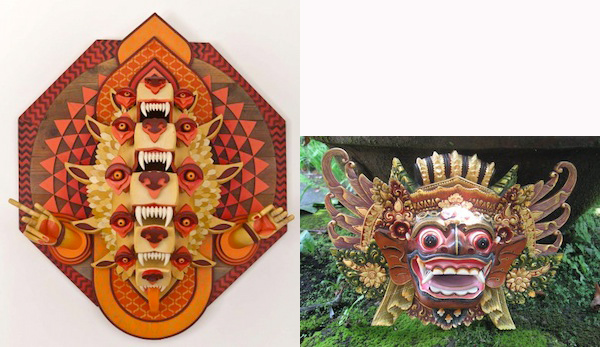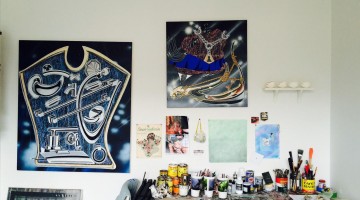
Image 1: AJ Fosik, “Bone Picker”, 41w x 47h x 16d”, Wood Paint & Nails, 2012. Image 2: Runnin' with the Devil.
AJ Fosik’s “Lamplighter to the Promised Land” at Guerrero Gallery has been covered by nearly every San Francisco-based online art publication. Most articles reiterate that Fosik’s work is inspired by various cultures and made with wood, which is basically an uncited quote of the press release. Whatever, this is fine for brevity’s sake. However, if you’re going to bother to expound on the work’s features, being mystified by Fosik’s “wide range of cultural backgrounds and religious iconography” is lazy (Guerrero Gallery). Could you read the work? I grew up with artist parents in Berkeley, took four years of art history courses and I can’t fucking read all of it. But I’ll try, because “Lamplighter to the Promised Land” is absolutely worth seeing, and making the effort to trace its references. If you think Fosik’s work is just folksy and trippy, you need to expand your art history vocabulary.

Image 1: AJ Fosik, “No Blood in Bone”, 41w x 47h x 16d”, Wood Paint & Nails, 2012. Image 2: Hand carved Barong Balinese Mask, Teak wood, 14"w x 10"h x 6"d.
First, let’s acknowledge the elephant in the room, which seems to be repeatedly ignored (with the exception of a FecalFace commenter three years ago): the wall-mounted works all resemble Barong dance masks from Bali. Barong is a life-long guardian spirit that takes several animal forms (lion, tiger, boar, etc.), and is represented by dancers wearing a wooden mask in Galungan celebrations. Galungan is a representation of dharma’s (right living) victory over adharma (godlessness), in which spirits and ancestors inhabit the masks (Coldiron, 229). The dances also involve mudras, symbolic hand gestures that “can offer benediction and protection and instruction” (Dole, 32). Mudras are in Buddhist, Hindu, and Jain art, so there is variation through religion, culture and eras.

Image 1: AJ Fosik, “The Damsels Weep for Thammuz”, 31in x 90in x 33in, Wood Paint and Nails, 2012. Image 2: Vitarka Mudra. 8th century wall painting at Bezeklik, Tarim Basin. Detail of image.
The bear reminds me of my favorite sculptures in less affluent Lake Tahoe neighborhoods. However, rather than paws, the bear has hands forming the vitarka mudra, “the gesture of argument (…) sometimes associated with Manjushri, the embodiment of knowledge, wisdom, and learning” (Sotheby’s).

Image 1: AJ Fosik, “Lamplighter to the Promised Land”, 36w x 70h x 15d”, Wood Paint & Nails, 2012. Image 2: Christus Ravenna Mosaic Sign of the Cross, "Master of Sant'Apollinare," Mosaic of a Ravennate Italian Byzantine workshop, 526 AD.
Those are probably not lackluster peace signs. One option is the Sign of the Cross, a gestural blessing and sign that Christians can employ for almost anything holy. It’s related to Christ’s much cooler gesture, forming “IC XC” with a hand, an abbreviation for Jesus Christ in Greek (IHCOYC XPICTOC). The “IC XC” gesture is to art nerds what spelling out “blood” with your hands is to upper middle-class white kids in America…or real Bloods.

Image 1: AJ Fosik, “Strange Regions in Search of Beauty, Awe or Terror”, 36w x 52h x 17d”, Wood Paint & Nails, 2012. Image 2: Eliphas Levi, "Baphomet", in Dogme et Rituel de la Haute Magie, 1855.
Are you a fan of conspiracy theories or Alex Jones? No? This is probably a representation of Baphomet, a Pagan character that represents duality (including gender and Heaven and Hell). If you’re interested in the paranoid flavor of Baphomet’s significance, YouTube videos tell stories with more intrigue and fervor than I ever could.
Symbols are full of meaning, and art historical ones are probably not referenced without reason. Visit AJ Fosik’s “Lamplighter to the Promised Land” at Guerrero Gallery to tease out what it means to you. The show closes December 8.
-Kendall George
Citations:
Coldiron, Margaret. Lions, Witches, and Happy Old Men: Some Parallels between Balinese and Japanese Ritual Masks, Asian Theatre Journal , Vol. 22, No. 2 (Autumn, 2005), pp. 227-248, Published by: University of Hawai’i Press, Article Stable URL: http://www.jstor.org/stable/4137132. Dole, Paul. Semiology, India International Centre Quarterly , Vol. 18, No. 4 (WINTER 1991), pp. 31-57, Published by: India International Centre, Article Stable URL: http://www.jstor.org/stable/23002244
Sotheby’s. Bodhisattva, Gilt copper with semi-precious stones, Nepal.” 19 March 2008. Web 24 November 2012. http://www.sothebys.com/en/catalogues/ecatalogue.html/2008/indian-and-southeast-asian-works-of-art-n08418#/r=/en/ecat.fhtml.N08418.html+r.m=/en/ecat.lot.N08418.html/309/+r.o=/en/ecat.notes.N08418.html/309/. Image Citations:
All images of AJ Fosik’s work via Guerrero Gallery. http://guerrerogallery.com/. Web 24 November 2012.
Hand carved Barong Balinese Mask, Teak wood, 14″w x 10″h x 6″d. http://www.nongnit.com/khonmask/bmynn008.html.Web 26 November 2012.
Vitarka Mudra. 8th century wall painting at Bezeklik, Tarim Basin. Detail of image. http://en.wikipedia.org/wiki/Mudra. Web 24 November 2012.
Christus Ravenna Mosaic Sign of the Cross, “Master of Sant’Apollinare,” Mosaic of a Ravennate Italian Byzantine workshop, 526 AD. http://en.wikipedia.org/wiki/File:Christus_Ravenna_Mosaic.jpg. Web 24 November 2012.
Eliphas Levi, “Baphomet”, in Dogme et Rituel de la Haute Magie, 1855. http://en.wikipedia.org/wiki/Baphomet. Web 24 November 2012.

